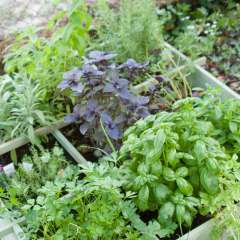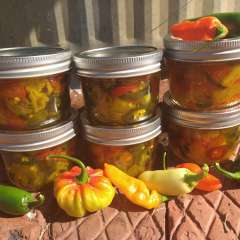Growing a vegetable garden is a lot of fun, but do you really eat what you grow? Many gardeners give up on gardening in part because they get overwhelmed, don’t plant the right things, or simply lose motivation. Thinking about the big picture and planning ahead can set you up for a more fulfilling, rewarding experience.
Why Grow Your Own Food
“Food storage is not enough because food storage is not food security. Food security is food production.” - William DeMille, regenerative farming expert and author of Worry-Free Eating.

Imagine growing a garden that not only feeds and sustains your family, but also is tastier, healthier, budget friendly, and fun. That’s the goal most vegetable gardeners, but it’s absolutely essential for the survival gardener. We’ve all seen what happens when big agricultural producers have a crop failure or a recall, or when something happens to supply lines. In a survival situation, you can’t rely on grocery stores, and your own personal stores won’t last forever.
Homegrown food beats out store-bought food in both taste and nutrition departments, too. Wholesome fruits, vegetables, herbs, and grains are much healthier than highly processed foods. When they’re grown in your home garden, you get an extra bump in both nutrition and flavor. The home gardener has the luxury of eating the freshest, most local food available, picked on site and often eaten the same day. Even when it is canned, frozen, or dried for long-term storage, the food you grow in your garden is grown in healthier soil, relies on fewer pesticides and synthetic fertilizers, has more chance to fully ripen on the plant.
Grow What You Eat
Most of you are already convinced that growing your own survival food is a great idea. But what about eating what you grow? Sometimes good intentions aren’t enough, which is why it’s important to think ahead and have a plan. Many people grow tomatoes or zucchini because they are easy and popular, but then feel overwhelmed. If you don’t eat tomatoes, or you only eat a little, you’re doing a lot of work for very little return. You’ll throw away the food, feel guilty, or give up.
Consider your current diet and your taste preferences. What do you eat already? Are there foods you’d like to eat more of, but can’t afford or find in the store? Buy more of these seeds and use them to create an ideal “garden menu.” It’s wonderful to explore and try new things, but don’t be tempted to plant something you know that you realistically won’t eat. If you only use a little of something, it’s okay to only plant a couple of plants or skip that one - even if it’s a garden staple like tomatoes! It’s better to share a half a packet of seeds with your neighbors than to give away your garden produce or let it rot before you harvest it.
What Seeds to Plant
After you’ve thought about what you generally like to eat and will get the best use out of, consider these options for a healthy garden that will provide food, nutrition, and other benefits for your family.
An Indoor or Outdoor Herb Garden

If you don’t know where to start, grow herbs! Every home should have its own herb garden. Many of the most flavorful herbs are extremely easy to start from seed, and can even be grown indoors.
- Culinary herbs - Basil, chives, sage, parsley, mint, and other culinary herbs are much cheaper when grown from seed, and when they are inexpensive and easily available, you can enjoy them more often. If you grow too much at a time, herbs are easy to dry or freeze for later use. Plus, they’re are packed with antioxidants and health benefits, so this is one of the easiest ways to get started eating what you grow.
- Medicinal herbs - These beneficial plants are also excellent additions to the survival garden, giving you ready access to hard to find and expensive options for pennies. It’s so rewarding and useful to have everything you need to prepare herbal teas, tinctures, and other remedies from medicinal herbs grown in your garden.
Summer & Warm Weather Crops
Starting in spring and moving into the warm weather of summer, you can grow an abundance of sun-loving crops. Of course summer crops are delicious fresh, but you can also harvest and store your excess so you can continue enjoying healthy fresh food in the cooler months.
- Beans and peas - There are so many options to choose from! Soybeans, pinto beans, cowpeas, snap peas, and green beans are relatively easy to grow from seed. They also store well; bulk dried beans can be safely kept in 10 gallon buckets for long periods of time. These legumes provide your family with high-quality protein and the plants will also add nitrogen to your soil.
- Corn - There’s nothing quite like fresh corn from the garden, but it’s also a great survival food that provides healthy carbohydrates. Depending on the type of corn you grow, you can dry it, mill it into corn meal, can it, or freeze it for long-term storage.
- Squash - Summer squash and zucchini are super easy to grow, and can be frozen or canned. They also make fantastic quick breads. Winter squash are also grown in the summer months, and can be cured and stored for a long time, providing tasty and hearty vegetables that add some flavor and vitamins that are wonderful for the winter months.
- Potatoes and sweet potatoes - Easy to grow and nutrient-dense, potatoes and sweet potatoes are winners in the survival garden. They store well in root cellars and dark places, too.
- Tomatoes - Fresh tomatoes are a garden favorite, but did you know that tomatoes are actually more nutritious once they’ve been processed? Enjoy your freshly picked tomatoes in summer on your sandwiches and in fresh salsa, but make sure to can some tomato sauce and paste for later, too.
- Cucumbers - Cool, fresh cucumbers add something special to your summer salads, and they’re also delicious when preserved as pickles or dried into cucumber chips!
- Melons - Freeze your excess melons and pickle your watermelon rinds to enjoy these tasty fruits for longer.
- Peppers - Whether sweet or hot, there are so many ways to process your peppers for long-term storage! (We recommend Cowboy Candy.)
-
Fruits, nuts, and berries - If you have the room, consider adding bushes and trees that will add to your food stores. These plants have long lifespans and can provide a variety of high quality foods to supplement your diet for decades.

Winter & Cooler Weather Crops
What you can realistically grow in the cool seasons depends on your growing conditions, but these plants are generally good choices for cool weather gardening. You may need to use a greenhouse or indoor gardening setup if your seasons have very harsh winters. And some of these crops can be grown in the summer in cooler climates, but may bolt, become bitter, or just fail in hotter climates.
- Cruciferous vegetables - Cole crops like cabbage, kale, broccoli can actually improve in flavor with a little frost. They provide much needed fresh nutrition during the winter months. Cabbage can be stored easily in a root cellar – just pull up the whole plant, root and all!
- Green leafy vegetables - Greens like spinach and lettuce can give winter gardeners some fresh flavor during the winter months. These easy to grow plants can also be grown indoors during the hottest months, providing you with year-round fresh salads and nutrition.
- Root vegetables - Beets, onions, and carrots develop better flavor when the cold alters their sugar structure. As a bonus, these veggies store exceptionally well and are the whole reason root cellars exist!
- Cereal grains - Wheat, oats, and barley can all be grown in the winter months. Keep grains in dry storage to enjoy unmatched whole-grain goodness straight from the garden.
Eat from Your Garden 365 Days a Year
As you can see, harvest season isn’t the only time you’ll be eating from your garden. When you’re planning, think ahead to long-term storage. If you like to pickle, can, or otherwise preserve your harvest, think about the work involved and make sure you allow yourself time and resources to do so. Don’t forget to consider how much storage space you have. If you have a deep freezer or a root cellar, you’ll be able to enjoy summer bounty well into winter. If you don’t, maybe you can team up with a family member or friend who has some extra space.
Many of us are reliant on the grocery store and food supply chains to feed us, especially those of us who live in the suburbs or the city. One easy solution for anyone who owns land is to become more self-sufficient and grow your own food. If you plan to plant foods that you enjoy eating and that you can easily store, you’ll be on your way to an enjoyable, rewarding experience that can help improve your quality of life and survive, even in emergency situations.
Want to learn more? Watch William DeMille’s Q&A session on YouTube about eating what you grow for more tips. https://youtu.be/ZWn89s2X99A
























